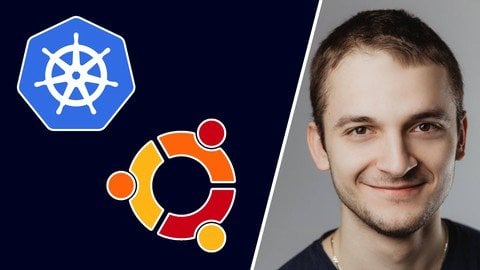
Published 2/2023
MP4 | Video: h264, 1280×720 | Audio: AAC, 44.1 KHz
Language: English | Size: 9.37 GB | Duration: 13h 27m
Kubernetes course for absolute beginners with hands on exercises directly in your local machine and also in AWS.
What you’ll learn
Understanding Kubernetes for application developers
Understanding containerization and Docker
Installing and using Kubernetes in local PC and in public cloud
Basic components of Kubernetes
CRUD operations and pod commands
Services and scaling in Kubernetes
Identity and access control in Kubernetes
Solid understanding of EKS offering in AWS
Requirements
Familiarity with basic Linux commands
Basic understanding of the command line
Familiarity with at least one programming language
No Kubernetes or public cloud experience is needed
Description
This course covers the essential concepts of containers and Kubernetes. It includes 14 sections and 63 lectures with a total length of 13 hours and 26 minutes. You will get an overview of what CKAD and Docker are, how to build Docker images, and what microk8s and Kubernetes are. The course also covers key components of Kubernetes such as pods, replica sets, deployments, and services, as well as topics like autoscaling, configmaps, secrets, and RBAC. The course also covers more advanced topics like ingress, daemon sets, jobs, storage class, persistent volumes, and stateful sets.The course covers AWS tools and how to create an AWS account, AMI admin user, and use the AWS CLI and Eksctl. You will also learn how to deploy a demo application and use blue-green and canary deployments. Additionally, you will learn how to authenticate users and service accounts, and use role-based access control.By the end of this course, you will have a comprehensive understanding of the fundamentals of containers and Kubernetes, and you will be equipped with the skills and knowledge to build, deploy, and manage applications in a production environment. Whether you are a beginner or an experienced DevOps engineer, this course has everything you need to get started with containers and Kubernetes.Why you should learn Kubernetes?Kubernetes is a powerful tool that helps organizations manage and scale their application infrastructure. It is the most popular open-source container orchestration platform and has been adopted by many of the world’s largest companies.Learning Kubernetes is important for several reasons. Firstly, it is the backbone of modern application development and deployment, and understanding how it works is essential for developing, deploying, and scaling applications in a efficient and scalable way. Secondly, the demand for Kubernetes expertise is growing rapidly as organizations move towards cloud-native applications and infrastructure. By learning Kubernetes, you will gain in-demand skills that are highly sought after by employers.Additionally, Kubernetes provides a lot of flexibility and control over your infrastructure. It allows you to manage and automate complex application deployments, and provides features like automatic scaling, rolling updates, and self-healing to ensure that your applications are always available and running smoothly. It also provides a unified way of managing containers, regardless of the underlying infrastructure, making it a platform-agnostic solution for managing your infrastructure.Finally, Kubernetes has a large and active community, which means that it is well-supported and constantly evolving. By learning Kubernetes, you will have access to a wealth of resources and a supportive community to help you with any challenges you may face.In conclusion, learning Kubernetes is important for staying ahead of the curve in modern application development and deployment, and for acquiring in-demand skills that are highly sought after by employers. With its growing popularity and robust feature set, it is a valuable investment of your time and energy.
Overview
Section 1: Introduction
Lecture 1 Introduction
Lecture 2 About me
Lecture 3 Course organization
Lecture 4 What is CKAD
Lecture 5 Source Code for this course
Lecture 6 Slides
Section 2: Container basics
Lecture 7 Introduction
Lecture 8 What are containers?
Lecture 9 What is Docker?
Lecture 10 Building docker image
Section 3: Kubernetes Installation (Microk8s)
Lecture 11 What is Kubernetes
Lecture 12 Kubectl
Lecture 13 Microk8s Introduction + installation
Lecture 14 Windows instructions
Lecture 15 (Windows) Microk8s installation
Lecture 16 (Windows ) Microk8s addons
Lecture 17 (Mac) Microk8s installation
Section 4: Kubernetes basics
Lecture 18 Kubernetes key components
Lecture 19 Namespaces
Lecture 20 Kubeconfig
Lecture 21 Autocomplete setup
Section 5: (Optional) Kubernetes Installation (AWS EKS) CHARGED
Lecture 22 Introduction
Lecture 23 AWS account creation
Lecture 24 AWS AMI admin user
Lecture 25 AWS CLI
Lecture 26 AWS Eksctl
Lecture 27 Kubeconfig info
Section 6: Pods
Lecture 28 Pods
Lecture 29 Kubectl commands
Lecture 30 Declarative configuration
Lecture 31 Debugging pods
Lecture 32 Command and Args
Lecture 33 Resource requests and Limits
Lecture 34 Liveness probes
Lecture 35 Readiness and Startup probes
Section 7: Deployments and Scaling
Lecture 36 Labels and Annotations
Lecture 37 ReplicaSet
Lecture 38 Deployment
Lecture 39 Rollback
Lecture 40 Autoscaling (Horizontal Pod Autoscaler)
Section 8: Configuration and Secrets
Lecture 41 ConfigMap
Lecture 42 Secret
Section 9: Services
Lecture 43 Service basics (ClusterIP)
Lecture 44 DNS
Lecture 45 NodePort
Lecture 46 LoadBalancer
Lecture 47 (Optional) EKS LoadBalancer CHARGED
Lecture 48 Ingress
Lecture 49 (Optional) EKS Ingress installation CHARGED
Section 10: Other Kubernetes Workloads
Lecture 50 DaemonSet
Lecture 51 Job and CronJob
Section 11: Volumes and Persistency
Lecture 52 EmptyDir
Lecture 53 HostPath
Lecture 54 Storage Class, Persistent Volume, Persistent Volume Claim
Lecture 55 Demo Application Deployment
Lecture 56 (Optional) EKS Demo application deployment CHARGED
Lecture 57 StatefulSet
Section 12: Authentication and Authorisation
Lecture 58 Authentication (Users and Service accounts)
Lecture 59 Role based access control (RBAC)
Section 13: CKAD bonus section
Lecture 60 Blue Green deployment
Lecture 61 Canary deployment
Lecture 62 JsonPath
Lecture 63 Custom columns
Section 14: Cleanup and conclusion
Lecture 64 AWS cleanup
Lecture 65 Conclusion
For software developers who want to learn Kubernetes.,For software developers who want to take CKAD (certified kubernetes application developer) exam.,For everyone starting with container technology.
Password/解压密码www.tbtos.com
转载请注明:0daytown » Kubernetes for beginners 2023 with AWS EKS examples